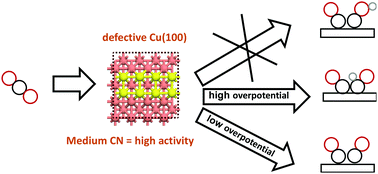Potential-dependent C–C coupling mechanism and activity of C2 formation in the electrocatalytic reduction of CO2 on defective Cu(100) surfaces†
Abstract
The potential-dependent C–C coupling mechanism for C2 formation in the electrocatalytic reduction of CO2 is studied on several defective Cu(100) surfaces, and a nonmonotonic trend is observed between the effective free energy barriers and the average coordination numbers. Further structural analysis reveals that Cu surface strain along the parallel and vertical directions with respect to the C–C bond would have distinct impacts on the modulation of the barriers.

- This article is part of the themed collection: 2021 Emerging Investigators


 Please wait while we load your content...
Please wait while we load your content...